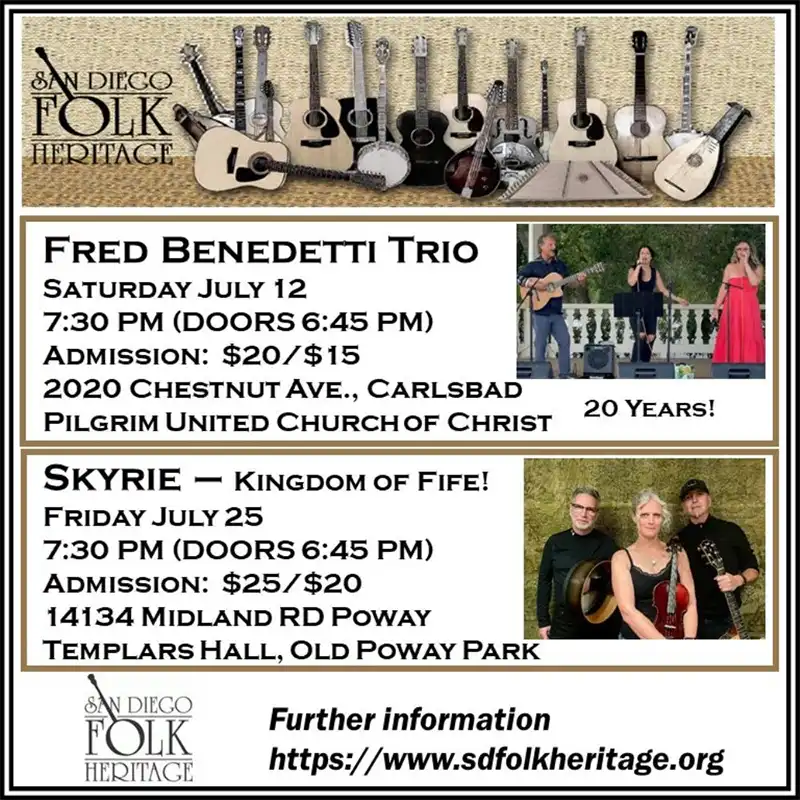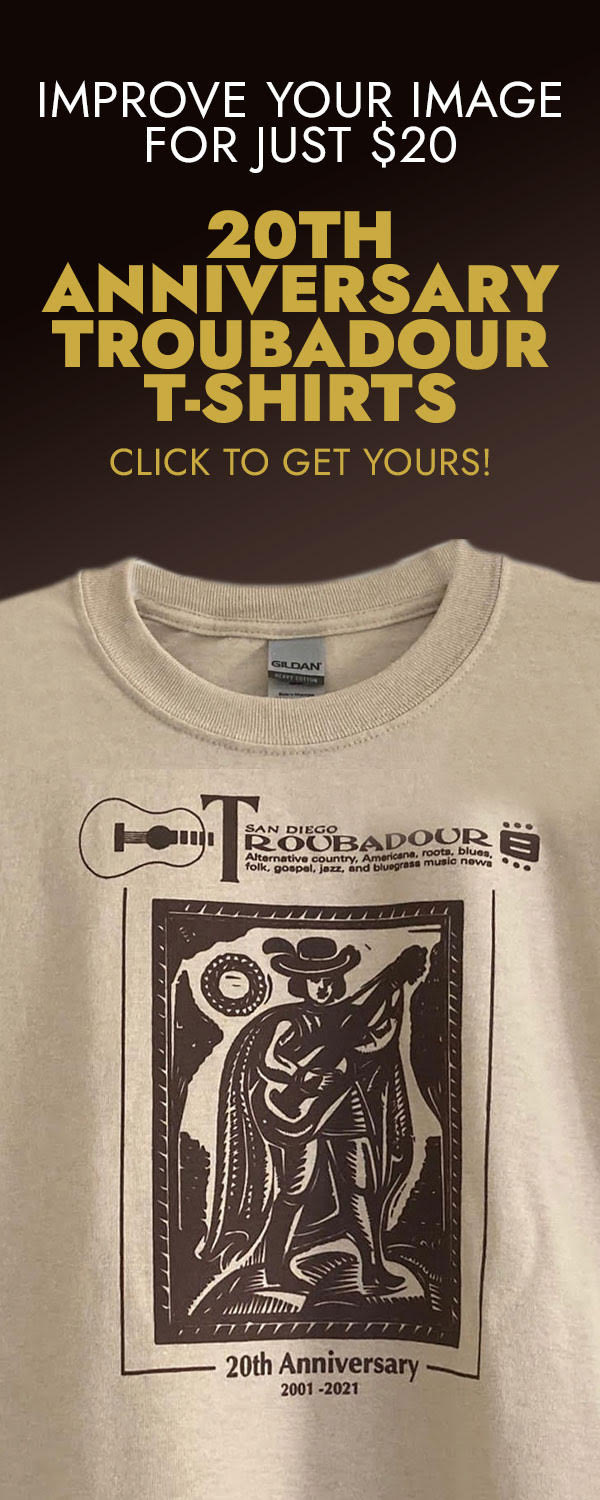Bluegrass Corner
Bluegrass Jamming Etiquette
Jamming is an essential part of bluegrass. Jamming occurs at every bluegrass festival and at virtually every other event where bluegrass musicians get together. In fact, jamming may well be the central aspect of modern bluegrass music, as there are many times the number of jammers as there are professionally performing musicians. And, it is undoubtedly true that jammers are the financial lifeblood of the bluegrass industry. It is jammers who buy most of the instruments, strings, capos, and assorted other accessories, and it is jammers who buy most of the concert and festival entry tickets.
So, what is the etiquette for jamming and how does one participate? Here are a few simple rules that will ensure that you and your jamming partners have a great time, that the music is good, and that you will be a welcome addition to a jamming circle.
Approaching a jam. Discreetly listen to a song or two from outside the circle. Note which instruments are already in the jam and decide if yours will contribute or be in the way. For example, if there is a bass in the jam and you are a bass player, move on — one bass per jam is the rule. If you are a guitar, mandolin, fiddle or dobro player, there is probably room for you even if your instrument is already represented, but if there are already three or more of your instrument, it is best to move on. If you are a banjo player, two banjos, maybe three if the players are “sensitive,” is about tops.
Listen to the style and type of music being played. Is it primarily a singing jam? An instrumental jam? Traditional bluegrass? New Grass? Old time? Will your playing fit in? Make a judgment before you jump in and then find out you don’t fit.
Ask to Join. Especially if you don’t know anyone in the jam, wait until a tune ends and then ask, “mind if I join you on guitar, fiddle, etc?” This will almost always get you a “yes,” unless what looked like a jam circle is actually a band scheduled to go on stage doing their warm-up, in which case you will be glad you asked in advance! By asking you make sure you are welcome, and you make sure the jammers note your presence, which will ensure that you get a turn when the breaks are passed around. If you simply lurk around the edges you may never get asked to take a solo break or to call a tune.
Be in Tune. Tune your instrument before approaching the jam. Unless you have perfect pitch, use an electronic tuner. Even the greatest player is not welcome out of tune!
HOW THE CIRCLE WORKS, OR THE PASSING AND CALLING OF THE TUNES
The Kick Off. Generally, one person in the circle picks a tune, calls out its name and the key in which it will be played. That person then starts the tune with an introduction to set the timing and rhythm. The introduction can, for example, be either counts of “potatoes” (rhythmic strumming) for an instrumental, or in singing songs by playing the last phrase of the chorus or a verse. This intro tells the other jammers what the pace and rhythm of the tune will be.
Playing the first verse. The person who called the song and did the kick off will then play the tune through completely once and only once. If it’s an instrumental usually two A parts and two B parts to the tune are played, comprising a complete “once through.” If it’s a singing song, the leader will sing the first verse and chorus. The rest of the jammers play rhythm if it’s an instrumental, rhythm and fills if it’s a singing song. Remember, the rest of the circle supports the person playing or singing lead — do not play too loudly or too “fancy.” If you can’t hear the lead player/singer, then you are too loud. If heads turn to see what you are doing instead of watching the lead, you are too “fancy.” Save the fancy stuff and volume for your turn to play/sing lead.
Passing the Tune. After the first verse is completed by the first person, the tune is passed to the next person in the circle. Pay attention to which way the circle is going so you will know when it will be your turn (some circles pass right, some left). When it comes to your turn, if the tune is instrumental, you play it through one complete cycle. This means you play it as the kickoff person did — the “A” part twice and then the second or “B” part twice. Then you pass it to the next person and play rhythm again. If the tune is a singing song, keep your eye on the person who called the tune as that person will indicate when the instrumental breaks are to be played. And pay attention to whether breaks are being played based on the verse or the chorus and play accordingly.
The Ending. When the tune has come all the way around the circle the person who called the tune will play it one more time if it’s an instrumental, and then put an ending on it. If it’s a singing song, that person will sing the last chorus, or maybe the last verse and chorus, and end. Usually, circle members may join in the ending riff.
The Next Tune caller. You have now completed one complete song cycle. The lead song caller roll should now pass to the next person in the circle who will call a new tune and the cycle starts over again. In this manner the lead is passed around the circle until everyone has had a chance to call a tune. Caveat: it doesn’t always work this way. Often you will find a jam with a core of 2-5 folks who know each other well and have worked up some material, with a handful of others sitting in on the jam. Often these “insiders” will call tunes, or pass the lead roll only among themselves. This is somewhat impolite, but if you encounter it just go with the flow. Often it is more fun to play with a group that has actually worked up material and knows what they are doing. If you are polite and contribute positively to the music you will eventually be asked to take a turn at lead.
When to Sing. When to sing and when not to sing are very important. If you called the tune, you will be expected to sing lead and to know the words to the verses and chorus. If you call the tune and want to sing harmony instead, you must so state before the tune starts and solicit someone else who can and will sing the lead. If you did not call the tune and want to sing along, offer before the tune starts that you will sing “tenor” or “baritone” or “bass.” If the song just starts, then listen — if no one is singing a harmony part that you can sing, then join in. If someone else is already singing that part, it is best to stay out. It is almost never a good idea to sing along with the lead, except on group songs like “Will the Circle be Unbroken.” When in doubt, don’t sing is the best rule. Remember, singing in a manner or at a time that conflicts with what the tune caller is doing is as bad as stepping on someone else’s instrumental break! Tip: Have a couple of standard tunes under your belt and be ready to go. These should be tunes for which you know a solid kickoff and ending and where you know all the words and can sing a strong lead. They should be tunes that most in the jam will know. When your turn comes, call one of these and things will go smoothly and the jammers will appreciate you!
When to Play. Knowing when to play and when not to play is very important. On instrumental tunes, when someone else has the lead the rest of the circle plays rhythm. Generally, one does not do fills on someone else’s instrumental break. Play at a low volume so the lead player can be heard easily. This means circle players must quiet down, especially for guitar leads. On a singing song, unless asked to do the kick-off, (often a banjo or fiddle will be asked to do the kick-off) circle players stay out of the kick-off or play rhythm. When the singing is going on, play a quiet rhythm, never so loud that the singer can’t be heard. It is also appropriate to play “fills” between singing phrases. But, you must pay attention to who else is playing fills — if six instruments all play fills at the same time there is no rhythm left and the fill noise will be out of control. Do not hog all the fills. If you play a few fills and think “this is cool, I sound great and no one else is doing fills,” get off your high horse! The others are being polite and letting you take a few fills — reciprocate and drop back to rhythm so they can play fills, too. You can play a little bit behind the singing, but be cautious — never too loud — and stay off the melody notes as these are likely to conflict with the singer, especially if you play fiddle or dobro as they are closer to the human voice.
Be Ready. Be ready when the circle comes around to you. If you do not know the tune — if it’s too fast or if for other reasons you do not want to take a lead — you can “pass” on taking a solo break, but tell the person next to you IN ADVANCE that you will be passing. It is very annoying to have the person next to you just not start when it is their turn, or say “pass” after the verse has started. Likewise, when it comes your turn to call a tune, be ready. Think of one in advance; don’t wait until it gets to you.
Include Everyone. When you are the tune caller it requires attention on your part. You must announce the name and key of the tune, you must note when everyone is ready (capo’s on, banjo strings in place, etc.) and you set the pace with a kick-off. Then, you must “direct” the tune around the circle. My strategy, which I recommend to you, is if you think everyone knows the tune, you can sing one verse and chorus and then pass the tune for a solo break to the next person. If it appears many of the jammers don’t know the tune, maybe sing two verses and choruses and then pass it. This will give the group twice as long to hear and learn the melody before they are asked to play it. Decide how many solo breaks occur before you sing another verse. This means you must know how many verses there are. For example, in a three-verse song, you want to pass solo breaks around the circle about in thirds, so that after the last solo it will be back to you for one final chorus and an ending. As the director for your song, it will be appreciated if you point , nod, or call out “guitar,” “fiddle” etc. to cue the next person to take a solo. Also, be ready for the “pass” indication from a circle member, including the late pass, and nod, point, or call out to the next person in line; it is your job to try and give everyone a chance to play a solo break who doesn’t “pass” and to have the song end smoothly back with you.
Leaving a Jam. It is usually nice, although not required, to indicate when you are leaving and to say “thanks for letting me participate.” At this point — if introductions haven’t already happened — you are likely to find out the names of your fellow jammers and to do some handshaking. This is an important part of jamming and will break the ice for the next time you see these folks or play with them. Follow these rules and you will quickly become a sought after jammer. Break them and you may wonder why you are not welcome!
Note: This is an updated version of the Bluegrass Corner that appeared in the June 2004 issue of the San Diego Troubadour.






